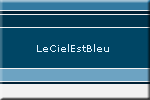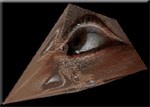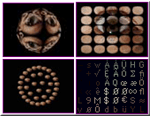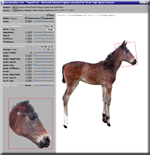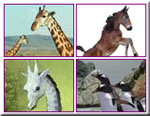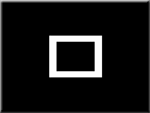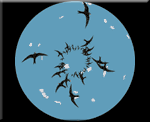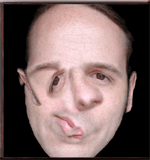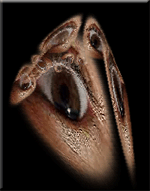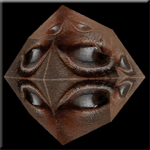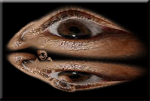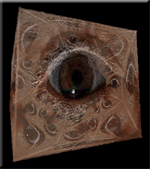|
|
|||
| Hi Frédéric, 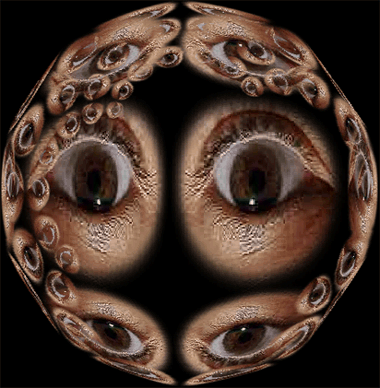 "Oeil Complex" has presence and character. And mystery. Would love to have a look at the source code. We'll see if Fred coughs it up to me. But even if he doesn't show the source code, the real interest is in the mystery of "Oeil Complex" and its being situated deep in the mind, as an entity of the mind, and as an entity arising from a meditation on the Platonic solids and the way that shapes fit together in 3D space. It is a deeply intellectual piece, although children can enjoy it. There are only five Platonic
solids possible: the tetrahedron, cube, octahedron, dodecahedron,
and icosohedron. Each face is the same shape and the angle between any
two contiguous faces is the same as the angle between any other two
contiguous faces. The Platonic solids were described by Plato in The
Timaeus ca. 350 BC. Plato equated the tetrahedron with the "element"
fire, the cube with earth, the icosohedron with water, the octahedron
with air, and the dodecahedron with what the constellations and heavens
are made of. They would also have known that there were only 5 of these
types of shapes possible (in Euclidean space).
|
|||
| Durieu
|
Hi Andrews I'm sorry for the delay but I was very very busy. I'm also sorry for my very bad english. Also thanks for your interest in my work. It's not the first time that someone has asked me so many questions about the source of "Oeil Complex".... I love your attempt at explanation but that's not
the good direction. The code is very very simple ... I can't give you my code but if you are a mathematician you can find the solution easily. Think of the name of the piece... |
||
| Andrews
|
Oops. It probably doesn't have anything to do with the Platonic solids! If I click "Oeil Complex" until I get the honeycomb-without-eyeballs, "Oeil Complex" reveals its structure more readily: all of the elements are quadrilaterals, whereas the Platonic solids have the cube, which has 4-sided faces, but also triangular faces and 5-sided faces. I imagine that's why this particular mode is there at all: to reveal structure. When did you do "Oeil Complex"? |
||
| Durieu
|
the code was created in 1999 | ||
| Andrews
|
What sorts of issues did you want to address in it? | ||
| Durieu
|
it's a kind of strange creature living in a different world. we are in a 3D world; Oeil complex is living in a 2.5D world ouuuuu. it's a plane trying to conquer the third dimension.... | ||
| Andrews
|
How do you think about this creature you have created? | ||
| Durieu
|
I like it very much because it's so strange, so alive. Also because the code behind this is so simple. I'm very proud of this... I hope that it (he)? will succeed in his quest to achieve 3D.... | ||
| Andrews
|
What are its moods, to you? | ||
| Durieu
|
I don't know. I was so surprised when I met this creature. It never speaks to me. I think that this creature is mute. It looks maybe a little bit desperate. |
||
| I find it quite accomplished
artistically, concerning programming, and mathematically. And very funny!
To me, it is located between the realm of the forms and this world.
It combines artistry and mathematics and programming beautifully. But
mostly it has an intriguing and intelligent presence as a work of art. |
|||
| Durieu
|
cool work Jim. did you try to make an interactive module with this? | ||
| Andrews
|
No. I was using Photoshop and
CorelPaint to do pieces, and a bit of Java, at that point, mostly in
96. |
||
| Durieu
|
I like the power of mathematics. But i always try to hide this aspect in my work. Mathematics is only an easy tool to build all my toys. (I say toy and not game because I don't like applications where you need to win.) |
||
| Andrews
|
Yes, well, mathematicians invented computers and mathematics is extremely useful to digital art, as your work indicates—or to any art in which the construction involves some sort of engineering amenable to mathematical analysis. Would you agree? | ||
| Durieu
|
Sure. Mathematics is so easy to translate into code for a computer. For me it's the simplest way to animate things on the screen. | ||
| Andrews
|
What were your favorite areas of mathematics? Did you do a degree in mathematics? What is your background, Fred? | ||
| I'm an engineer (the real name in belgium is civil engineer ) (the school was equivalent to the ecole polytechnique in france). I don't really have a main center of interest in mathematics but most of the time I use kinetic (physics) laws to move things on screen with acceleration and friction. I like very much the fact that I don't need to be exact (mathematically speaking) in my work. only the final effect on the screen is important. sometimes, errors or the side effect in the code give very interesting results. It's exactly the opposite of what I learned in my studies. what do you think about puppettool? It's my main work now and it gives me a lot of pleasure. |
|||
| Andrews
|
I would compare it with sodaplay.com, which you probably know. Your creatures have more grace to them than the sodaplay creatures, I would say. | ||
| Durieu
|
I met this guy one time in Paris . He is very cool. I think it's one of the best things on the internet. | ||
| Andrews
|
You are exploring the interesting line between the tool and the work of art. Do you think of Puppettool as a work of art or a tool? Or some mixture? Do you think there is tension between the idea of a tool and the idea of a work of art? | ||
| Durieu
|
For me it's a tool to define puppet states. Before this tool, it's was very difficult (for the giraffes) I had to put all the coefficients in a big array! But now it's also a creation place. I've received 500 states from the users and some are incredible, real pieces of art. So it's maybe somewhere in between tool and art? i don't know. | ||
| Andrews
|
I know your Puppettool is up for the transmediale award, Fred—bon chance! | ||
| Durieu
|
You are well informed! Thanks | ||
| Andrews
|
Have you found the "Zoo" work to be more popular than "Oeil Complex"? If so, why is this, do you think? | ||
| Durieu
|
Yes, the zoo has had a huge success. Probably because animals are more accessible (realistic)? | ||
| Andrews
|
Is this work an extension of the work on "Oeil Complex" or is it totally different work? | ||
| Durieu
|
totally different work but my work is always full of mathematical or physical laws. | ||
| Andrews
|
How would you describe your main concerns as an artist-programmer? | ||
| I'm using a lot of complicated algorithms , but the aim of all this is to create poetry So, I like to speak about algorithmic poetry. A poem is a text that procures you poetry if you read it. The code I'm trying to write is a text that procures you poetry if a computer reads it for you.... | |||
| Andrews
|
Ha ha! Yes, you give it some interesting work to do, which doesn't often happen. Such an art is incomprehensible to most—though they can appreciate the computer's reading. Are there other works of yours that you would like to mention? |
||
| Durieu
|
I like "week-end" , the zoo and puppettool shortcuts are www.LeCielEstBleu.com/weekend www.LeCielEstBleu.com/zoo www.LeCielEstBleu.com/puppettool And one of my best works is the "Alphabet" CDROM. 15 prizes in the world.... It's a compilation of 50 interactive screens (Oeil complex is also included in with others graphics and with the microphone reactivity). Amazon is selling it in North America (it's a tivola product)—Dadamedia.com sells it in Europe. While I was working on Alphabet, I met Jean-Jacques Birgé. It was a real pleasure to work with him on the interactive musique. He his incredibly creative and we still work together regulary on LeCielEstBleu. |
||
| Andrews
|
I note that you and Antoine Schmitt and Nicolas Clauss all seem to share an interest in programming motion. Is this something you talk with them about? | ||
| Durieu
|
Antoine Schmitt is a wonderful programmer (he was working for NeXT before). But when i see him, we rarely talk about programming. Nicolas Clauss is not really a programmer but a painter who replaced his paint brushes for Director. We met 2 years ago after he'd seen Alphabet. I showed him Director. We became friends quickly and some time after he began to make his beautiful site flyingpuppet. | ||
| Andrews
|
What other concerns and interests do you share with Schmitt, Clauss, servovalve and Jean-Luc Lamarque? | ||
| Durieu
|
In Paris there are a lot of events around new media ... and parties. We like to speak together about the projects we are doing. | ||
| Andrews
|
You all use Director and are artist-programmers. How did this come about? | ||
| Durieu
|
Director remains THE tool to do interactivity. Lingo is so flexible so easy and so powerful. Schmitt , Lamarque and me have been using Director for a long time (10 years). I speak Lingo like I speak French. | ||
| Andrews
|
Do you think of this situation as unusual—that you are part of such a talented group of artists that all use the same tool and are web.artists in the same vicinity? It seems very splendid to me. | ||
| Durieu
|
I think there are a lot of artists using Director in the world. I don't think that the situation is unusual. It's maybe because we are coming from the CD-ROM world (now dead). It's a kind of redeployment. | ||
| Andrews
|
What do you do for a job? | ||
| Durieu
|
There still are some cd-roms to program in Paris. I participate in some exhibitions (some we receive money for). My girlfriend Kristine Malden from NYC, the eye in "Oeil Complex", works with me most of the time. We created together the SetSearch module . A kind of intelligent engine to find music. She is doing also web sites... Sometimes we do some modules for other companies (we are now working with Nike on puppets—look at the mp3 player). | ||
| Andrews
|
How long did you work on "Oeil Complex"? | ||
| Durieu
|
a very short time. 1 day. | ||
| Andrews
|
1 day? I can't believe it! How long is the code? | ||
| Durieu |
141 lines. |
||
| Andrews
|
Er, sort of. | ||
| Durieu
|
"oeil complex" is only a very simple function (transformation of the X-Y plane ). The 3D strange effect is only 5 of 6 lines of code. | ||
| Andrews
|
Is this a stereoscopic projection? It has been a while for me concerning complex analysis! And I may have been away that day! | ||
| Durieu
|
complex numbers are in an imaginary
plane. the imaginary number is "i", where i * i = -1. in the module , i is the vertical axis. |
||
| Andrews
|
I was lousy in complex analysis, so be gentle, Fred. What does it mean to have an i axis? Usually it is a z (real) axis. This is about where I bailed out of the course! The quaternions aren't far away. | ||
| Durieu
|
it's not easy to explain all the theory but here is a introduction to the complex numbers: http://www.ping.be/math/complget.htm. |
||
| Andrews
|
OK, I have read that—I had seen that material before. | ||
| Durieu
|
Do you know the Mandelbrot set (fractal)? | ||
| Andrews
|
I just had a look at http://math.bu.edu/DYSYS/MANDMAP/mandmap.html, so I see a bit of what is going on there. | ||
| Durieu
|
What I did in "Oeil complex" is not far from this but with a different function and with only one iteration of computation. | ||
| Andrews
|
The mandelbrot is a set of complex numbers that satisfy a certain condition. Yours is a mapping, using polar coordinates, of a square (presumably centered at the origin?) under a complex function. Where the mouse position determines the value of c and the argument is one of the vertices of the square? | ||
| Durieu
|
bravo i'm impressed. |
||
Ha ha, thank you, thank you. I like this sort of elegant puzzle, Fred. Important and high level mathematics in the service of art. Bravo to you for creating such a fine work! But I am still curious about the general nature of the function. The more eyes, the more it seems to tend toward a mapping on a sphere. The fewer eyeballs, well, the mapping is odd and suggests the Platonic solids--though I understand that may be the wrong approach. What is going on here? |
|||
| Durieu
|
it's only because we are working with the complex numbers. If you see how odd the mandelbrot set is and the complexity of his structure when you zoom in. I don't know exactly what kind of shape it produces here. It seems to be a sphere but I'm not sure (if the number of facettes = infinity). a lot of different functions give very good (strange) results. |
||
| Andrews
|
Ah, now that is fascinating, and I can sort of see what you mean. Are you talking specifically about complex functions? How would you describe the types of functions you're referring to? | ||
| Durieu
|
the function is 1/ (a+bi). Simple things are often beautiful! No? |
||
| Andrews
|
Mais oui! Merci, frère! |
||
| Durieu
|
The pleasure was for me, Jim. | ||
|
|||
